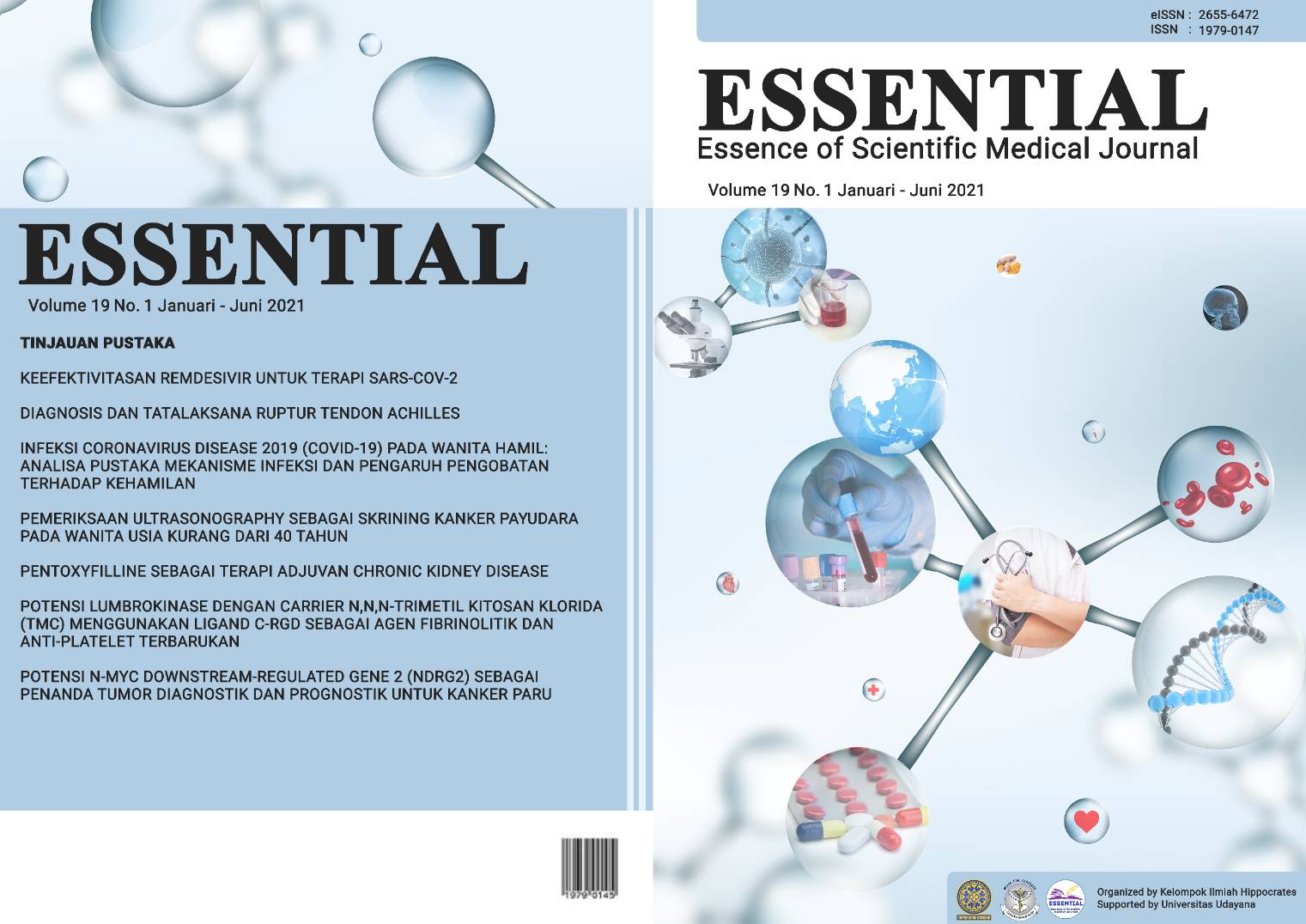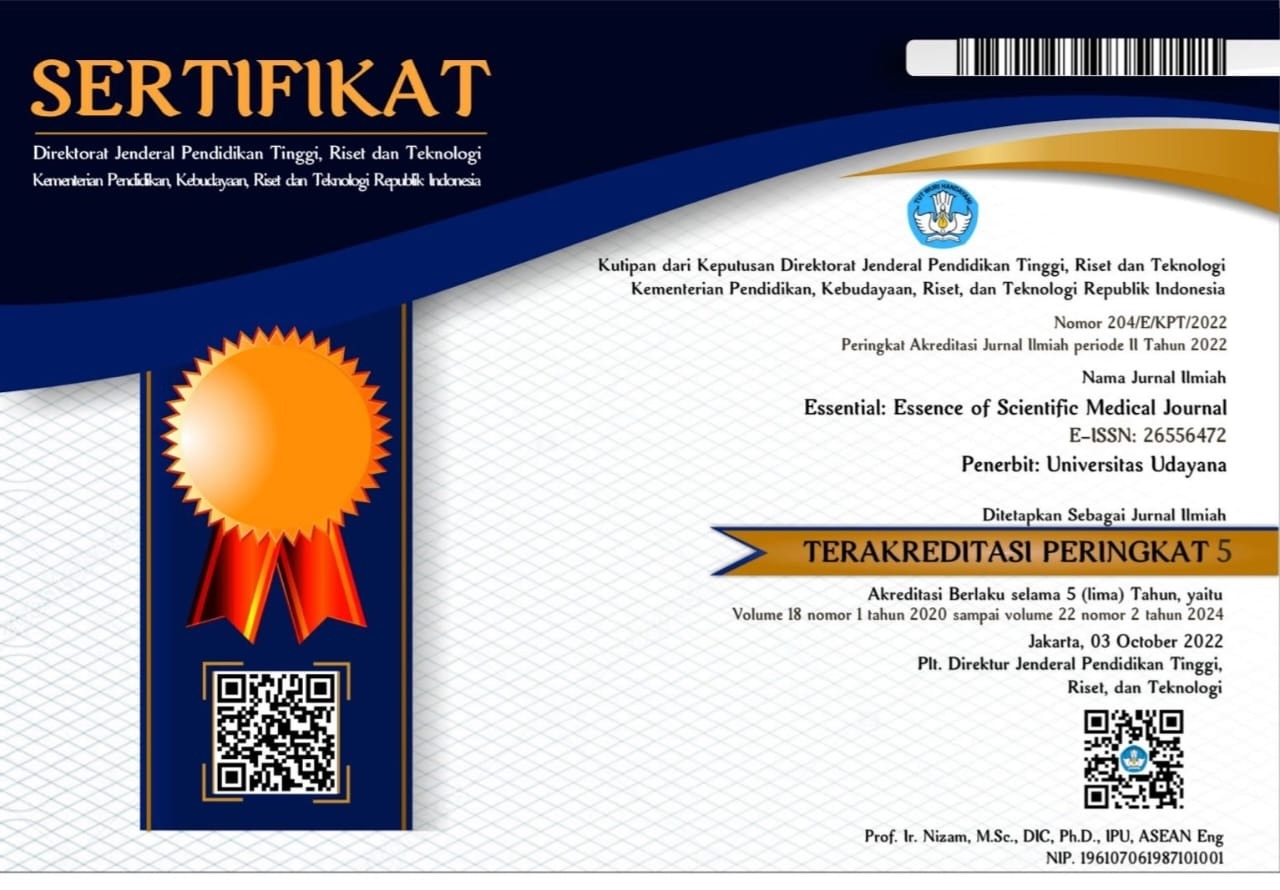The REMDESIVIR EFFECTIVENESS FOR SARS-COV-2 THERAPY
Abstract
Pendahuluan : SARS-CoV 2 termasuk dalam famili coronaviridae dan genus ?-CoV yang memiliki rantai RNA tunggal positif dengan memiliki protein struktural utama. yaitu Spike (S) yang akan berikatan dengan reseptornya, yaitu Angiotensin Converting Enzyme 2 (ACE2). SARS-CoV2 telah menjadi pandemi dengan total jumlah kasus diseluruh dunia mencapai 1.777.666 jiwa. Terapi yang digunakan saat ini adalah Hidrocloroquin dan makrolid. keduanya bekerja sebagai imunomodulator. namun hidrocloroquin memiliki resistensi. oleh karena itu diperlukan terapi yang mempunyai mekanisme target molekul virus RNA lainnya.
Metode : Penulisan dibuat berdasarkan tinjauan jurnal yang relevan dengan topik yang akan dibahas, jurnal yang digunakan adalah jurnal dalam 5 tahun terakhir. Berdasarkan jurnal yang telah dikumpulkan dan dilakukan analisa serta komparasi antar jurnal, digunakan 22 jurnal dari total 30 jurnal . kata kunci yang digunakan adalah ‘SARS-CoV-2, Hydroxychloroquine, azitromisin, dan Remdesivir.
Pembahasan: SARS-CoV-2 adalah ?-coronavirus (CoV) yang merupakan famili coronaviridae, subfamili Orthocoronavirinae memiliki RNA rantai tunggal positif. Seperti halnya SARS-CoV, virus ini membutuhkan Angiotensin Converting Enzyme 2 (ACE2) sebagai reseptor untuk memasuki sel, yang ditemukan pada saluran pernapasan bawah manusia. Virus memasuki sel, antigen akan dipresentasikan pada Antigen Presenting Cells (APC), menyebabkan terjadi badai sitokin, memicu ARDS dan kegagalan organ yang pada akhirnya menyebabkan kematian. Untuk melawan SARS-CoV-2, pengobatan masih berdasarkan penelitian coronavirus lainnya, SARS dan MERS. Dari penelitian-penelitian sebelumnya, kombinasi hydroxychloroquine dan azitromisin menjadi pilihan utama. Kombinasi kedua obat ini dapat menurunkan replikasi dan viral load, dan dalam suatu penelitian dapat menyembuhkan 100% penderita SARS-CoV-2. Namun mekanisme kerja yang belum terbukti, maka penelitian masih dilakukan untuk menemukan anti-SARS-CoV-2 yang poten dan mekanisme kerja pada RNA virus. Dalam literatur ini, kami memfokuskan terapi SARS-CoV-2 yang menjanjikan seperti Remdesivir, sebagai alternatif hydroxychloroquine dan azitromisin.
Kesimpulan: Remdesivir memiliki aktivitas antivirus in vitro dan in vivo terhadap beragam virus RNA yang tidak dapat dilakukan oleh chloroquine.
Downloads
References
2. Guo YR, Cao QD, Hong ZS, Tan YY, Chen SD, Jin HJ, et al. The origin, transmission and clinical therapies on coronavirus disease 2019 (COVID-19) outbreak - an update on the status. Mil Med Res. 2020;7(1):11.
3. Li X, Geng M, Peng Y, Meng L, Lu S. Molecular immune pathogenesis and diagnosis of COVID-19. J Pharm Anal [Internet]. 2020;19(xxxx):1–7. Available from: https://doi.org/10.1016/j.jpha.2020.03.001.
4. Song W, Gui W, Wang X, Xiang Y. Cryo-EM structure of the SARS coronavirus spike glycoprotein in complex with its host cell receptor ACE2. PLoS Pathog. 2018;14(8):1–19.
5. Xu Z, Shi L, Wang Y, Zhang J, Huang L, Zhang C, et al. Pathological findings of COVID-19 associated with acute respiratory distress syndrome. Lancet Respir Med [Internet]. 2020;8(4):420–2. Available from: http://dx.doi.org/10.1016/S2213-2600(20)30076-X.
6. Daga MK, Kumar N, Aarthi J, Mawari G, Garg S, Rohatgi I. From SARS-CoV to Coronavirus Disease 2019 ( COVID-19 ) - A Brief Review. 2020;6(4):1–9.
7. Liu J, Cao R, Xu M, Wang Xi, Zhang H, Hu H, et al. Hydroxychloroquine, a Less Toxic Derivative of Chloroquine, is Effective in Inhibiting SARS-CoV-2 Infection In Vitro. Cell Discovery. 2020; 6: 16.
8. Al-Bari AA. Chloroquine Analogues in Drug Discovery: New Directions of Uses, Mechanisms of Actions and Toxic Manifestations from Malaria to Multifarious Diseases. J Antimicrob Chemother. 2015; 70: 1608–1621.
9. Belizaire R, Unanue ER. Targeting Proteins to Distinct Subcellular Compartments Reveals Unique Requirements for MHC Class I and II Presentation. PNAS. Oktober 2009; 106(41): 17463-17468.
10. Zimmermann P, Ziesenitz VC, Curtis N, Ritz N. The immunomodulatory Effects of Macrolides—a Systematic Review of the Underlying Mechanisms. Front Immunol. 2018; 9(302): 1-14.
11. Min JY, Jang YJ. Macrolide Therapy in Respiratory Viral Infections. Mediator of Inflammation. 2012; 649570: 1-9.
12. Nabirotchkin S, Peluffo AE, Bouaziz J, Cohen D. Focusing on the Unfolded Protein Response and Autophagy Related Pathways to Reposition Common Approved Drugs against COVID-19. Preprints. 20 Maret 2020. Available from: https://doi.org/10.20944/preprints202003.0302.v1
13. Vincent MJ, Bergeron E, Benjannet S, Erickson BR, Rollin PE, Ksiazek TG, et al. Chloroquine is a Potent Inhibitor of SARS Coronavirus Infection and Spread. Virology Journal. 2005; 2(69): 1-10.
14. Keyaerys E, Li S, Vijgen L, Rysman E, Verbeeck J, Van Ranst M, et al. Antiviral Activity of Chloroquine against Human Coronavirus OC43 Infection in Newborn Mice. Antimicrob Agents Chemother. Agustus 2009; 53(8): 3416-3421.
15. Liang R, Wang L, Zhang N, Deng X, Su M, Su Y, et al. Development of Small-Molecule MERS-CoV Inhibitor. Viruses. Desember 2018; 10(12): 721.
16. Devaux CA, Rolain JM, Colson P, Raoult D. New insights on the antiviral effects of chloroquine against coronavirus: what to expect for COVID-19?. Int J Antimicrob Agents. Published 1 Maret 2020. Available from: https://doi.org/10.1016/j.ijantimicag.2020.105938
17. Yao X, Ye F, Zhang M, Cui C, Huang B, Niu P, et al. In Vitro Antiviral Activity and Projection of Optimized Dosing Design of Hydroxychloroquine for the Treatment of Severe Acute Respiratory Syndrome Coronavirus 2 (SARS-CoV-2). Clin Infect Dis. Published 9 Maret 2020. Available from: https://doi.org/10.1093/cid/ciaa237
18. Gautret P, Lagier JC, Parola P, Hoang VT, Meddeb L, Mailhe M, et al. Hydroxychloroquine and Azithromycin as a Treatment of COVID-19: Results of an Open-label Non-randomized Clinical Trial. Int J Antimicrobial Agents. Published 20 Maret 2020. Available from: https://doi.org/10.1016/j.ijantimicag.2020.105949.
19. Andreani J, Le Bideau M, Duflot I, Jardot P, Rolland C, Boxberger M, et al. In Vitro Testing of Hydroxychloroquine and Azithromycin on SARS-CoV-2 Shows Synergistic Effect. Mediterranee Infection. Published 2 April 2020. Available from: https://www.mediterranee-infection.com/wp-content/uploads/2020/03/La-Scola-et-al-V1.pdf
20. Rosa SGV dan Santos WC. Clinical trials on drug repositioning for COVID-19 treatment. RevPanam Salud Publica. 2020; 44:e40. Doi.org/10.26633/RPSP.2020.40.
21. Zhang W, Zhao Y, Zhang F, Wang Q, Li T, Liu Z, Wang J. The use of anti-inflamatory drugs in the treatment of people with severe coronavirus disease 2019 (COVID-19): The experience of clinical immunologist from china. 2020. doi: 10.1016/j.clim.2020.108393
22. Yang Y, Islam MS, Wang J, Li Y, Chen X. Traditional Chinese medicine in the treatment of patients infected with 2019-New Coronavirus (SARS-COV2): A review and perspective. 2020. 16(10): 1708–1717. doi: 10.7150/ijbs.45538.


 SUBMISSION
SUBMISSION
















